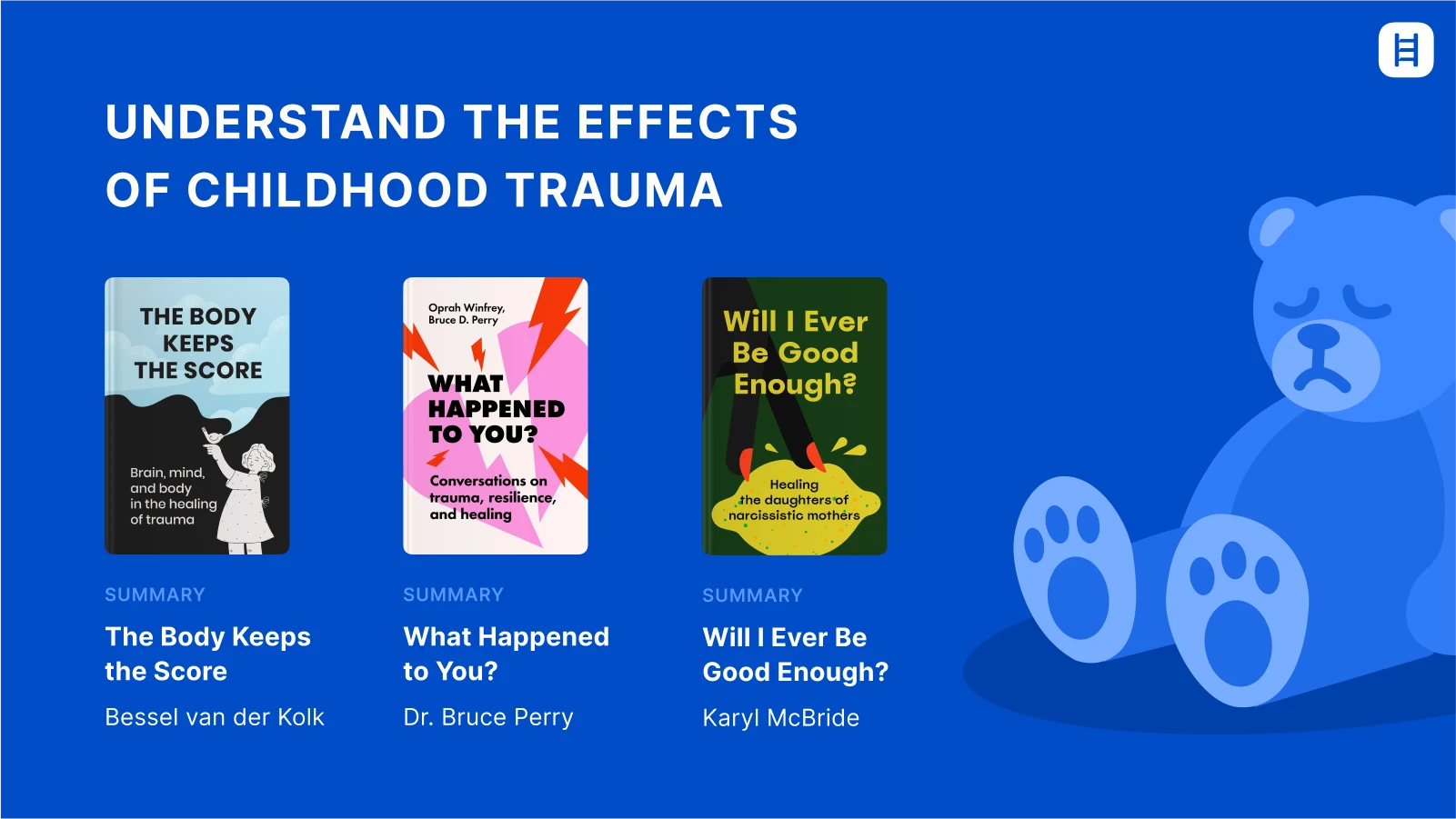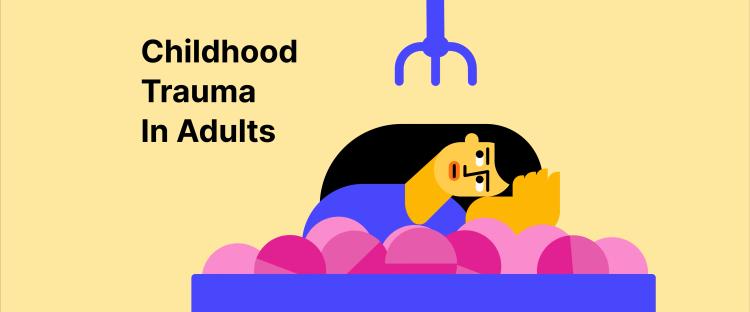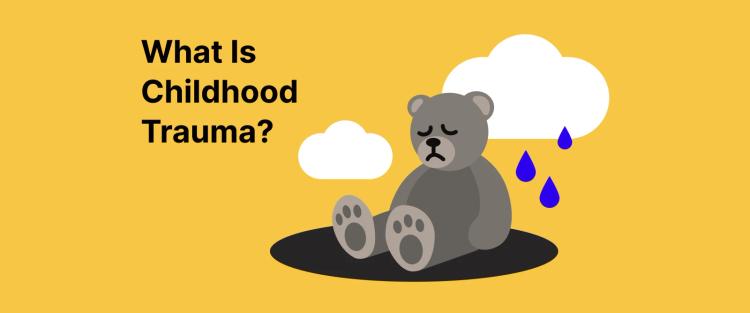Childhood trauma refers to deeply distressing experiences during childhood, such as abuse, neglect, loss, or exposure to violence. These events disrupt a child's sense of safety, leading to long-term emotional, physical, and psychological consequences.
Dr. Bessel points out that as an adult, you might not remember everything that happened, but your body holds on to past experiences. Overreacting or constantly second-guessing might be survival responses from things you went through as a child. The ACEs (Adverse Childhood Experiences) Study shows that over 60% of adults who experienced at least one adverse childhood event displayed long-term effects. And those who experienced four or more were twice as likely to develop heart disease or depression.
This guide can help you start healing with grounded strategies and self-trust insights from leading books.
Here's a quick breakdown of key strategies on how to deal with childhood trauma:
Acknowledge that the trauma happened.
Work with a trauma-informed therapist.
Learn emotional regulation techniques.
Practice mindfulness and self-care daily.
Read expert advice to better understand and reframe your experience.
What childhood trauma is and how it affects you long-term
When experts talk about childhood trauma, they usually mean child abuse, the loss of a parent, domestic violence, instability, emotional abandonment, and natural disasters. These experiences can seriously affect how a child handles their emotions and relationships and even cause flashbacks.
Trauma throws your nervous system off and can lead to hypervigilance, emotional dysregulation, and changes in memory, including stress hormone production. As mentioned above, the more traumatic events you've had, the higher your risk for mental health disorders, heart disease, emotional abuse, and other long-term health issues, all of which make it hard to stay calm or remember things clearly at times. Understanding this or figuring out how to heal (ideally with mental health professional help) can help you take control of it.
Effective ways to heal from childhood trauma: a therapist-approved guide to recovery
You might think your trauma issues were just your own experience, but actually, they're pretty common. We'll break this down by explaining what each issue looks like, how it might come from childhood, and some ideas on how to handle it. You can heal your trauma; it just takes time and the right tools:
1. Start with professional help
The best first step is to find a trauma-informed therapist. With professional support and proper literature, you can better understand how trauma affects both your brain and body. It is essential to ask for help with body-based therapies (especially when addressing the lasting effects of severe sexual abuse). A trauma-informed expert will guide you through processing painful memories safely, ensuring you don't become overwhelmed or forced to relive experiences before you're ready. In addition to these approaches, you may also explore other types of therapy, such as:
Cognitive Behavioral Therapy (CBT) focuses on recognizing and changing unhelpful thought patterns and behaviors and is used to manage anxiety or depression.
Trauma-Focused Cognitive Behavioral Therapy (TF-CBT) is an evidence-based treatment designed to help children, adolescents, and their caregivers overcome the mental health conditions and emotional and psychological effects of trauma.
Eye Movement Desensitization and Reprocessing (EMDR) uses guided eye movements that help the patient process and release traumatic memories; basically, it's the brain reframing painful events.
Somatic Therapies focus on how your body holds trauma by investigating complex PTSD symptoms.
Body-based Practices like deep breathing and mindful movement help regulate the nervous system and overcome traumatic memories.
What you can expect from a therapy session
Therapy sessions usually involve talk therapy, guided breathing, grounding exercises, or movement-based approaches, depending on what feels right for you. You can start with:
Talking about what's going on.
Learning new ways to handle feelings.
Slowly working through memories or reactions.
The goal is to help you feel safer and more in control. Your therapist will listen to your story, help you learn to manage your feelings, and guide you through processing painful memories. For example, if you've ever had a wave of emotions that hits you out of nowhere, therapy can help you trace it back to what triggered it and stay more present with your feelings. Your therapist may also suggest reading materials that offer key insights into how trauma affects you and explore powerful ideas to help you heal.
2. Create emotional safety daily
You need to build a calm environment inside and outside yourself. What does it mean? According to 'Emotional Intelligence 2.0' by Travis Bradberry & Jean Greaves, building a sense of safety every day is key.
You can use tools to further understand and manage your emotions:
Focus on routines and safe spaces. Set up simple routines that help you feel steady, like having a regular sleep schedule or a quiet, safe spot at home where you can relax.
Use grounding techniques when you feel overwhelmed. One easy method is the 5-4-3-2-1 technique. Name 5 things you see, 4 things you hear, 3 things you feel, 2 things you smell, and 1 thing you taste. It can help to bring you back to the present moment.
Build small habits that keep you calm. Start with deep breathing, gentle movement sessions, or listening to music you like. These little things add up and help your nervous support system settle over time.
Such exercises can even help you recognize and understand your emotions, including your triggers from child trauma. You can also improve self-regulation and learn to control impulses and manage reactions to stay calm.
3. Reframe and process through knowledge
Reading books about early childhood trauma can be powerful. For example, they can help you understand your experiences by clearly naming them, such as emotional neglect or trauma. This can make it easier to process what happened. Some well-known titles include:
'Running on Empty' by Jonice Webb explains childhood emotional neglect and its hidden impact on adults and offers ways to recognize trauma and heal.
'Complex PTSD from Surviving to Thriving' by Pete Walker covers complex PTSD from prolonged trauma with practical tools for managing symptoms and recovery.
If you're too busy to read entire books, Headway provides short summaries highlighting key points and helpful tips for overcoming childhood trauma, emphasizing that healing requires self-compassion. They offer advice on:
Restoring a healthy sense of self.
Managing health problems.
Building healthy relationships.
Healing self-harm behaviors and more.
4. Rebuild your identity and self-worth
As complex trauma can leave you feeling lost, journaling is a great way to explore your feelings. For example, you can track your progress by:
Writing affirmations. Make positive statements that remind you of your worth and strength; you can say things like, “I am healing one day at a time.”
Beginning compassionate self-talk. When negative thoughts come, gently challenge them instead of beating yourself up. For example, you can think of how you would comfort a friend going through the same thing and give that kindness to yourself.
Rebuilding is also about the impact of inner dialogue on your thoughts. According to 'Negative Self-Talk and How to Change It' by Shad Helmstetter, you can apply practical strategies to turn negative thoughts into positive affirmations, a method supported by CBT or cognitive processing therapy principles. In this book, you'll find step-by-step techniques that describe how to overcome self-doubt and support and build a more confident mindset.
Keeping calming tools like breathing apps, soft music, and helpful books handy gives you instant access to simple guidance and practical exercises to shift your perspective on key pain points.
Why healing is possible (and necessary)
We don't truly leave childhood behind when we grow up. Childhood experiences, especially traumatic ones, often leave marks that shape our self-image in adulthood. Dr. Karyl McBride's work 'Will I Ever Be Good Enough?' highlights how these early wounds aren't just memories; they affect our emotional patterns, boundaries, and sense of worth. One of the deepest, most lasting wounds is childhood traumatic grief. What is it, and what constitutes a traumatic event?
The loss of a loved one, a sibling, or a primary caregiver in childhood isn't just a heartbreaking memory. It can leave a lasting mark on how you trust, relate to others, and see yourself. Traumatic experiences often leave emotional imprints on us and shape our behavior long after the event itself is over. To begin the healing process, you first need to let go of a few common myths that can hold you back.
Myth 1: You just have to move on
Truth: Trying to rush yourself or bury what happened only delays healing and can even increase the risk of substance abuse or substance use disorder (some who have experienced adverse childhood experiences or ACEs turn to alcohol or drugs as a way to cope with unresolved pain). So, it is better to keep in mind that grief, particularly the effects of childhood trauma, doesn't follow a set timeline. First of all, you need space, support, and safety to work through it.
Myth 2: If it happened years ago, it shouldn't still bother you
Truth: Time doesn't automatically heal child trauma, and if something hurts you deeply as a child, it's likely shaped how you see yourself or connect with others today. It's okay if you're still carrying it, and it's okay to start unpacking it now.
Myth 3: It wasn't bad enough to count as trauma
Truth: If it left a mark, it matters. Whether you lost someone, felt abandoned, or had to grow up too fast, your body and mind remember. You don't need anyone's permission to take your pain seriously.
Myth 4: Healing childhood trauma is only possible when you're young
Truth: Healing can happen at any age. Your brain's ability to change means recovery is always possible with the right support and time for a long-term recovery plan. So you can eventually rebuild emotional health.
Mental health research shows that the brain can change throughout life, a concept called neuroplasticity. Studies from places like Harvard and Stanford show that therapy and support help rewire the brain, improving mood swings and overall well-being. It's also important to note that long-term recovery isn't just hope; it's an evidence-based process. Research published in the Journal of Trauma & Dissociation highlights how people heal from childhood trauma even decades later with proper help, therapy, and emotional support.
Holistic approaches to support healing
After childhood trauma, you might find yourself reacting in all kinds of ways. However, coping mechanisms will help you handle stress or big emotions, sometimes without even realizing it. Some of those responses can help, while others might be ways just to get through the moment. But to truly heal, we need to look at all the tools for your nervous system and your spirit.
1. Mindfulness and meditation
You can find practices like deep breathing and guided meditation to help calm your nervous system and build emotional awareness. You don't need to be an expert; just starting with a few minutes a day using a mindfulness app can make a difference.
You might notice how your stomach gets tight when you think about a particular person or how you lose your words when someone asks you a direct question. With meditation, these reactions can improve.
2. Movement and nutrition
How does childhood trauma impact your adult life? It shapes how your body reacts to stress, which is why caring for your body is essential. Healing isn't just mental; it's physical, too. Include physical activities like walking, yoga, or CrossFit in your daily routine. Such activities help release stored stress and clear out excess adrenaline.
Nourishing your body with balanced meals also supports brain health. Research indicates that diets rich in fruits, vegetables, whole grains, and healthy fats are associated with reduced stress and improved mood. People who adhere to a Mediterranean diet tend to have lower instances of eating disorders, stress, and anxiety compared to those consuming a Western-style diet, which is high in processed foods and sugars. So, yes, movement and food actually support you.
3. Creative healing
You've probably heard that music therapy can help you feel better. Actually, according to research, music therapy can really ease symptoms of depression and anxiety, especially for people who've been through trauma. It is about creative healing that allows people to express feelings that are often difficult to put into words, activating parts of the brain linked to emotions and memory. Here are some ways you can try it:
Drawing or painting freely
Playing or listening to music
Writing stories or poems
Journaling
Singing or even humming
Dancing or expressing movement
Creating collages or scrapbooking
Starting creative or nature photography
Working with DIY clay or crafts
How does it work? Research in fields like neuropsychology has shown that creative arts therapies reduce symptoms of post-traumatic stress disorder (PTSD) and improve emotional regulation. These practices help bypass the brain's logical centers and connect directly with emotions, making them powerful tools for recovery. This approach is especially essential because trauma often remains trapped in the body and nonverbal memory rather than manifesting through clear language. Best books to understand and process trauma.
Sometimes, therapy isn't available or might just be too much to start with. A book summary can step in as a gentle first guide, especially when you're trying to understand the effects of childhood trauma. Such summaries break things down in a way that feels clear. Here are some titles that stand out for their clarity:
1. 'The Body Keeps the Score' by Bessel van der Kolk
As was mentioned above, this is a widely respected book that explains how trauma is stored in the body and mind. The author explores various therapies that help people recover, including neurofeedback, mindfulness, and movement therapies. This Headway summary provides insight into why trauma affects both physical and mental health.
2. 'What Happened to You?' by Dr. Bruce Perry & Oprah Winfrey
This one doesn't ask what's wrong with you; it asks what happened to you. While reading this book, you will quickly learn that it breaks down how trauma shapes the brain and behavior, especially in kids. If you've ever felt an emotional delay, where you respond calmly in the moment but spiral later, this work helps explain why that happens. You can also find real stories and expert insights there.
3. 'Will I Ever Be Good Enough?' by Karyl McBride
Focused on healing from childhood emotional neglect and narcissistic parenting, this book helps readers understand the lasting effects of parental dysfunction. It also offers guidance on building self-worth. In it, you'll find useful tips on healthy relationships and more.
4. 'It Didn't Start with You' by Mark Wolynn
If you've ever felt a deep sadness or fear and couldn't figure out why, this book can help. It's about inherited family trauma or how emotions might actually be echoes of unresolved pain from past generations. M. Wolynn also offers exercises to help identify patterns and provides research in epigenetics and family member systems theory. That is about how trauma can pass down through generations, not just through family dynamics.
5. 'The Deepest Well' by Dr. Nadine Burke Harris
First and most important point: You can understand how childhood stress impacts your health in the long term. This book makes science personal as Dr. Harris shows how emotional responses that seem "too much" are often just normal reactions to abnormal early experiences. She also talks about physical symptoms, such as chronic illness, addressing the question, "Can trauma impact physical health?" She presents science in an accessible way by blending storytelling with case studies and data.
If you start with the basics, there's no need to read all the most popular books at once. You can take it slow with just 10–15 minutes a day with the summaries from the list above. And as always, reading or listening to these summaries in the Headway app gives you short, direct takeaways, including journaling prompts and practical exercises to help you become more aware of what's really going on inside.
Resources for ongoing help
Recognizing that many trauma responses are normal reactions to abnormal environments is crucial. For example, it could be poor motivation, low self-esteem, difficulty with routines, or emotional overwhelm. Many trauma-informed therapists say that with tools like therapy or support groups, your inner adult can slowly start to care for the inner child. Here are other crucial and trusted ways to support the ongoing help:
1. Helplines and directories
If you're feeling overwhelmed, crisis helplines and mental health directories are available in many countries and regions. They can connect you to immediate emotional support, local services, and like-minded communities. A global directory like FindaHelpline is a good place to start, helping match your needs with verified resources. If you are in the US, you can check SAMHSA or the Substance Abuse and Mental Health Services Administration.
2. Therapy finder tools
Certain platforms can help you search for a licensed therapist based on your budget, preferred therapy style, or type of issue you're working through. Whether you're looking for online sessions, trauma-informed healthcare, or something more flexible, these tools can help narrow your options:
BetterHelp
Open Path Collective
3. Headway's curated book list
You'll find a curated book collection of reliable sources inside the Headway app. You can check trauma, PTSD, and other recovery titles broken down into concise, powerful summaries. Many of them include:
Journaling prompts: short reflective questions or writing ideas designed to help you process what you've just read
Guided self-reflection: 10 daily minutes of clear, supportive resources and exercises that support greater self-awareness
Practical steps & tools for emotional responses: techniques for managing emotions and working with your inner child
Take steps toward healing with Headway's trauma-focused book summaries
Healing from childhood trauma can feel overwhelming, but small steps truly matter. Many children experience emotional wounds that last into adulthood, and childhood trauma survivors often struggle with feeling vulnerable. The Headway app gives you easy access to expert book summaries that explain how trauma impacts the brain and body. Spending just a few minutes a day can provide valuable insights and practical tools to support your emotional healing and self-care.
With Headway, you can explore trusted titles like 'The Body Keeps the Score,' which offers science-backed knowledge and real-life stories to guide your recovery. Check out books like 'It Didn't Start with You' to uncover how inherited trauma patterns influence your present, or 'Will I Ever Be Good Enough?' for those healing from difficult or emotionally distant parents. Whether you're seeking interventions, trauma treatments, or support for adolescents, Headway offers valuable resources.
Get one idea at a time. Begin your healing process by subscribing to the Headway app and gaining practical insights and strategies from expert summaries!
Frequently Asked Questions About Childhood Trauma in Adults
How to heal childhood trauma on your own?
While professional help is ideal, self-healing is possible through mindfulness, journaling, grounding exercises, and reading expert-backed resources. Practices like somatic movement and emotional regulation can help you reconnect with yourself and gradually release stored trauma.
How long does it take to heal from childhood trauma as an adult?
Healing timelines vary widely. It may take months or years depending on the depth of trauma, your support system, and the tools you use. Progress is non-linear, but every small step counts toward long-term recovery.
Will I truly ever heal from childhood trauma?
Yes—research shows healing is possible at any age. Neuroplasticity allows your brain to form new patterns, especially with trauma-informed care, self-awareness, and consistent support. Recovery doesn’t erase the past, but it builds resilience and peace.
Is childhood trauma lifelong?
Childhood trauma can have lifelong effects if unaddressed, but it doesn’t have to define your future. With proper support, therapy, and self-care, you can rewire trauma responses and lead a meaningful, emotionally healthy life.
Can trauma change your personality?
Yes, trauma can shape behavior, emotional responses, and identity—often leading to hypervigilance, emotional withdrawal, or people-pleasing. These shifts are protective adaptations, not flaws—and with healing, core personality traits can re-emerge and thrive.
What are the 6 stages of healing from childhood trauma?
Though models vary, common stages include:
safety,
acknowledgment,
processing memories,
grieving losses,
rebuilding identity, and
reconnection.
Healing isn’t linear—but these stages offer structure for reclaiming your inner stability.















